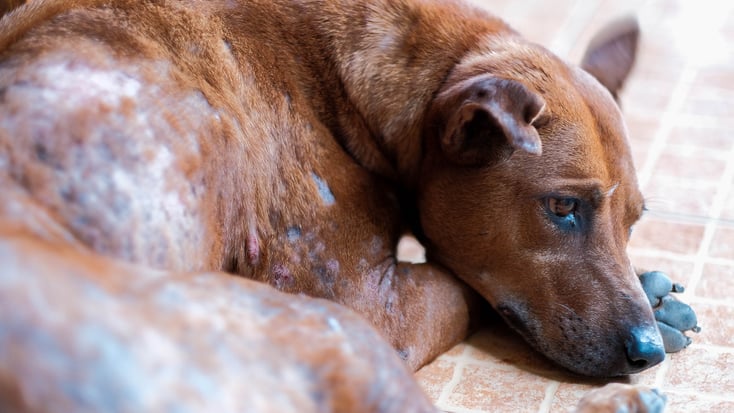Mange in Dogs: Symptoms, Causes, & Treatment

Table of Contents
Mange is a common skin condition in dogs caused by parasitic mites. It can lead to various symptoms, including intense itching, hair loss, and skin irritation. If left untreated, mange can worsen and lead to secondary infections or other complications.
Read on to learn about how to recognize the signs of mange, take appropriate preventive measures, and seek prompt treatment. Let's ensure that our furry companions receive the care they deserve and regain their comfort and happiness.
Key Takeaways:
- Mange is a skin condition in dogs caused by parasitic mites and can lead to intense itching, hair loss, and skin irritation.
- Sarcoptic mange is highly contagious and can be transmitted to humans, while demodectic mange is not contagious.
- Prompt veterinary care and following the treatment plan are crucial for the effective management of mange in dogs.
What Is Mange in Dogs?
Mange refers to a group of skin diseases caused by different types of mites. The two most common types of mange in dogs are sarcoptic mange (also known as scabies) and demodectic mange (often called red mange). While both are caused by mites, they involve different types of mites and their effects on dogs’ skin.
Mites are microscopic parasites that cause skin disease (mange). Sarcoptic mange is caused by Sarcoptes scabiei mites, which burrow just beneath the skin's surface and cause intense itching, inflammation, and crust formation.
Demodectic mange, on the other hand, is caused by Demodex canis or Demodex injal mites, which naturally inhabit the hair follicles of dogs. When these mites multiply excessively, they can cause patchy hair loss, chronic skin infections, and other complications.
Signs & Symptoms of Mange in Dogs
Mange in dogs can present with various clinical signs. Here's a list of symptoms to look out for:
- Hair Loss: Bald patches may appear on the dog's skin due to mange infestation.
- Skin Irritation and Redness: Mange-infected skin becomes inflamed, leading to redness and visible irritation.
- Skin Thickening and Darkening: The skin may thicken and darken in affected areas, indicating the presence of mange.
- Scab or Crust Formation: Crusty or scabby skin patches can form due to mange, contributing to the discomfort.
- Unpleasant Odor: Mange can produce a foul odor due to bacterial growth on the affected skin.
- Excessive Scratching: Dogs with mange often scratch excessively, attempting to relieve their discomfort.
- Secondary Infections: Intense scratching can lead to secondary bacterial or fungal skin infections.
- Systemic Effects: Severe cases of mange may lead to weight loss, decreased appetite, lethargy, and swollen lymph nodes.
It's important to address both the localized skin issues and the potential systemic effects of mange to ensure the dog's overall health and well-being. Visit a veterinarian if you notice any of these signs of dog mange.
Hassle-free In-Home Pet Sick Visits
When your pet isn't feeling well, the last thing you want is a stressful trip to the vet. Our in-home sick pet visits offer a calm, stress-free alternative.
Causes of Mange in Dogs
Mange in dogs is primarily caused by various types of mites, including Sarcoptes scabiei, Demodex canis, and Cheyletiella mites. These mites lead to different forms of mange, each with specific characteristics and effects on dogs' skin and health.
Here's a breakdown of each type and cause:
Sarcoptic mange
Sarcoptic mange, also known as scabies, is a highly contagious skin disease caused by the Sarcoptes scabiei mite. While primarily affecting dogs, this form of mange can also be transmitted to humans. Female mites burrow into the skin to lay their eggs, which hatch in approximately three weeks. The young mites then feed on the host's skin, perpetuating the infestation.
Symptoms typically manifest approximately 10 days to 8 weeks after coming into contact with a scabies-infested dog or when dogs spend time in areas that foxes frequent.
Initially, signs of the infection tend to emerge on the pinna (ears), chest, elbows, hocks, and belly. If left untreated, signs can spread to other locations.
Demodectic mange
Demodectic mange, or demodex, is caused by Demodex mites, specifically Demodex canis. These mites naturally inhabit the hair follicles of dogs without causing any issues in healthy individuals. However, when a dog's immune system is weakened or compromised, an overgrowth of these mites can occur, leading to demodectic mange. It is important to note that Demodex mites are not contagious between animals.
Dogs susceptible to demodectic mange include:
- Puppies due to having an immature immune system (juvenile-onset demodicosis)
- Adult dogs with weakened immune systems due to age, illness, malnutrition, or adverse effects of medication (adult-onset demodicosis)
Cheyletiella mange
Cheyletiella mange, also known as walking dandruff, is caused by Cheyletiella mites. These mites are larger compared to other mange-causing mites and can be seen with the naked eye. They live in the top layer of dogs' skin and cause flaking, scaling, and itching. Cheyletiella mange is contagious and can be transmitted between animals and humans.
Diagnosis of Mange in Dogs
The diagnostic process typically includes the following:
- Physical exam findings and history: The location and appearance of the skin lesions, degree of pruritus, medication history, and concurrent illness can facilitate diagnosis and differentiation between mange types.
- Skin Scraping cytology: Veterinarians scrape the affected areas of the dog's skin to obtain samples. These samples are then examined under a microscope to detect the presence of mites or their eggs.
- Hair Samples: After collecting hair samples from the affected areas, they can be examined under a microscope to identify mites or their debris, providing valuable insights into the type and severity of the mange infestation.
In addition to these primary diagnostic methods, veterinarians may recommend further tests or procedures depending on the specific case. These can include fecal testing, polymerase chain reaction (PCR) testing, and ELISA antibody testing for more accurate identification of mite species.
In severe or complicated cases, a skin biopsy may be performed. Response to therapy can also facilitate diagnosis.
Treatment for Mange in Dogs
Treatment options for mange aim to eliminate the mites, alleviate symptoms, and promote skin healing.
Topical medications are commonly prescribed to target localized mange areas. These medications often contain ingredients like imidacloprid and selamectin, which effectively kill mites and help alleviate itching and inflammation.
In more severe or widespread cases of mange, oral medications or injectable medications may be necessary. These medications work systemically to kill mites throughout the body.
It's important to note that mange treatment requires a tailored approach, and veterinary dermatology guidance is crucial. Regular follow-up visits may be necessary to monitor progress and adjust the treatment plan as needed.
Prevention & Management of Dog Mange
Preventing and managing mange in dogs requires proactive measures to minimize the risk of infestation and effectively control the condition.
It's also important to maintain a clean living environment by regularly cleaning and disinfecting bedding, toys, and shared spaces. Additionally, it's crucial to avoid contact with infected animals, as scabies and Cheyletiella are highly contagious. Limit interactions with stray or known infected dogs to reduce the risk of transmission.
Regular veterinary checkups are essential for monitoring your dog's health, detecting early signs of mange, and instituting appropriate preventive and treatment measures. If your dog develops mange, promptly following your veterinarian's treatment plan and recommendations, including medication administration and hygiene practices, is vital for effective management.
Conclusion
In summary, mange is a common skin condition that can profoundly affect our canine companions' overall health and happiness. If you notice any signs of mange in your furry friend, reach out to a veterinarian for professional assistance. With their expertise and care, we can alleviate discomfort and restore our dogs' vitality.
Frequently Asked Questions
Is dog mange contagious?
Yes, scabies and Cheyletiella can be contagious and can be transmitted from dog to dog through direct contact.
Can humans get mange from dogs?
Yes, humans can contract certain types of mange from infected dogs, including sarcoptic mange. The mites that cause mange in dogs can temporarily infest human skin, leading to itching and discomfort.
Can mange kill a dog?
Mange itself is not typically a life-threatening condition for dogs. However, if left untreated, severe cases of mange can lead to secondary infections and significant discomfort, which can have a negative impact on a dog's overall health and well-being.
How does a dog get mange?
Dogs get mange from mites, microscopic parasites that can be transmitted through contact with an infected animal or environment. Mange can also be passed from mother dogs to their puppies, and factors like weakened immunity, stress, and poor hygiene increase susceptibility.
How to get rid of mange in dogs?
Mange in dogs is treated through veterinary interventions, including topical medications, systemic medication, and environmental decontamination.






